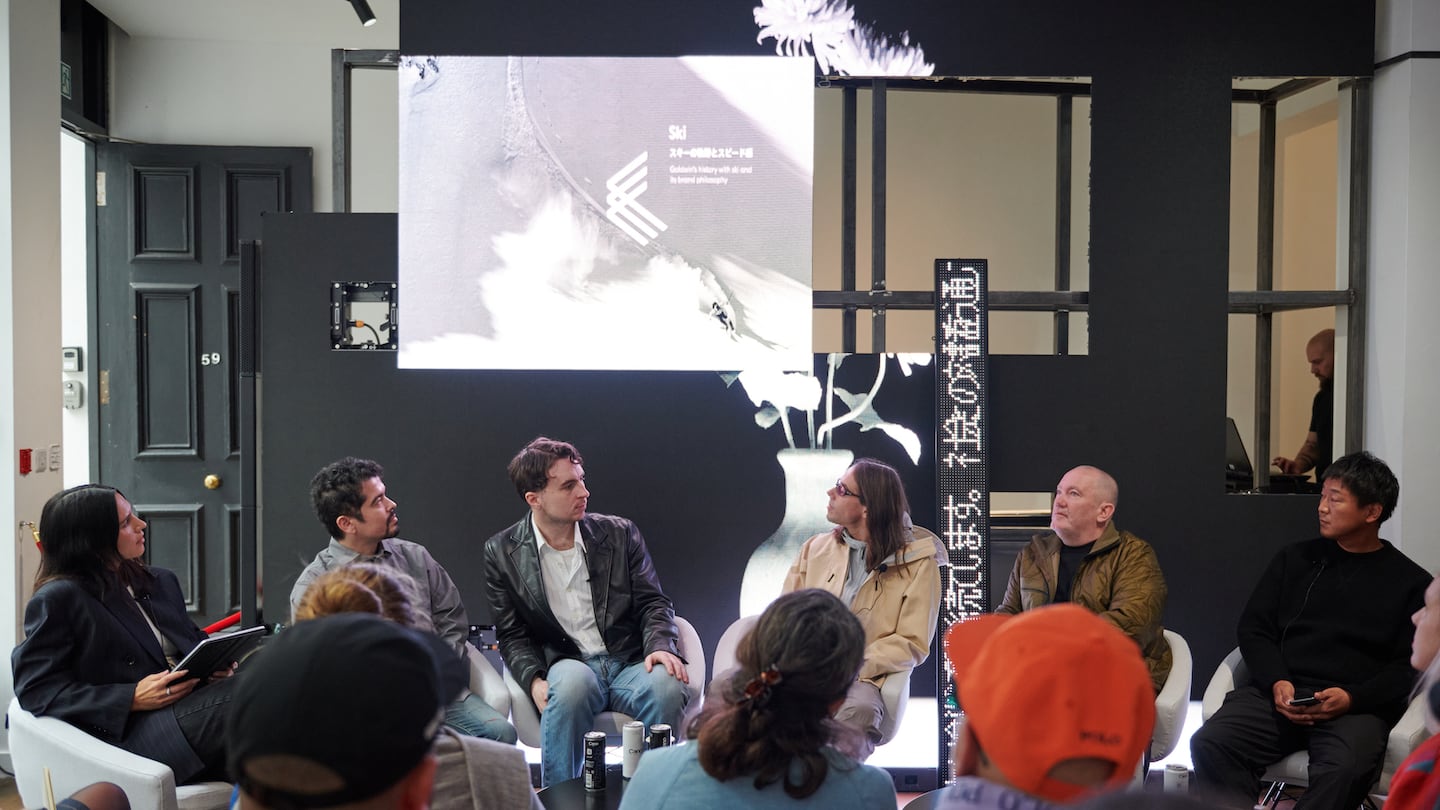
The Business of Fashion
Agenda-setting intelligence, analysis and advice for the global fashion community.

Agenda-setting intelligence, analysis and advice for the global fashion community.

Last week, Japanese premium technical apparel brand, Goldwin launched its first capsule collection in collaboration with manufacturing biotech partner, Spiber Inc. — using Brewed Protein materials.
The launch featured a panel discussion, co-hosted by cultural commentator and moderator Phoebe Lovatt alongside the two brands and panellists that included Takuya Kinami, general manager of Goldwin, Alec Leach, former editor at Highsnobiety and author and strategist in sustainable fashion, Andrew Groves, professor of fashion design at the University of Westminster and director of the Westminster menswear archive, Sam Trotman, owner of modern media platform Samutaro, and Kenji Higashi, executive vice president of Spiber’s sustainability division and representative of Spiber Europe.
The intimate panel discussion shed a light on Goldwin and Spiber’s design and manufacturing partnership, highlighting its use of Brewed Protein materials, a trademarked material of Spiber Inc., which were used to craft the exclusive product range. Spiber’s Brewed Protein materials are produced through a fermentation process that utilises sugars, rather than petrochemical or animal-derived raw materials.
Today, more than two thirds of apparel originate from fossil fuel inputs, and a growing accumulation of garments are destined to outlive purchasers’ grandchildren in landfills. Even natural materials like leather or wool have a hefty environmental footprint and are often coated with synthetic chemicals and plastic finishes to ensure performance and durability.
Analysts estimate that over the past 10 years, some $3 billion has been invested into innovating the fabric of the fashion industry, driving the initial adoption of next-generation materials like mushroom leather, lab-grown fibres and recycled textiles.
“We’ve been working with Spiber for a long time, and we’ve finally been able to launch a wide range of products at a commercial scale,” shared Kinami.
“It’s taken us over fifteen years to develop this material to the stage where we are now able to master this commercial scale and to offer it to the world, that’s a huge achievement for us,” added Higashi.
“Brewed Protein fibres primary raw ingredients [are] biomass-based nutrients such as sugars. We feed sugars to microbes that have been programmed to produce specially designed proteins. They then produce the protein polymer, and we can process into a wide range of forms — such as fibres, resin, leather, etc. [Our] technology is a platform that allows us to design materials according to end-use needs. The materials in this collection are only one example of what our technology allows us to produce,” he continued.
Below, BoF shares key insights from the discussion, from details on the purpose behind the collaboration, what new innovative materials mean for the changing landscape of today’s consumers, importance of regulation supporting future growth and the challenge in circularity.

TK: It’s fundamental to our approach as a manufacturer of apparel [to invest in new fabrications for products], it’s just something you need to be doing. This collaboration began back in 2015 and [has been] is a big goal for both the company and for society. I don’t differentiate between doing this because it’s good for Goldwin and doing it because it’s good for society.
We believe that Brewed Protein fibres can be used to develop lots of new types of materials. As Spiber goes on to develop these new materials, Goldwin will use them in our designs and in launching new products — we’re very positive about continued commercialisation.
Goldwin [has] always strived as a brand [to be synonymous] with [the] timelessness of design, colour and detail. Working with Spiber to solve some of the issues that society and the industry face, the importance of this consistency of design is something we’ve only become even more aware of. Where possible, we want to use the style and design of our garments to also fit in with this idea of timelessness and making pieces that people aren’t going to tire off and will wear longer — extending the life cycle of the garment.
AL: What Goldwin and Spiber are doing is making a start in addressing the biggest impact in the industry — any work that you’re doing to make fabric and make clothes in a less harmful way is a really, really big deal.
What was happening a lot when I was working at Highsnobiety, streetwear was becoming this huge thing, that you’d have an entire ecosystem on Grailed or Depop. You start getting [the] products [that were] dropped being instantly sold as secondhand, then those garments tend to be sold ten times in six months. So, you end up with this cycle of secondhand shopping that actually really looks like fast fashion, because it’s still that same, really quick movement.
When it comes to us as consumers, the biggest difference we can make in our shopping habits is by buying less stuff. Then the stuff that you do buy, just wear it until it falls apart. Ask yourself, “do I actually want to own this or am I just trying to scratch the itch?”
AG: What really struck me when we started acquiring the archive is actually the quality of clothing that people [had] in occupational time, working on the trains. When they got nationalised, the quality dropped and the quantity of fit and production all just became about making the cheapest thing as quickly as possible — to fit the most number of people. It’s reflective of what’s happened in the fashion and clothing industry now, that rush to just keep on producing.
We see the consumption of fashion nowadays, a show that hasn’t even finished has already been judged or consumed. Garments haven’t even made it to retail before they’ve been dismissed. Fashion designers really need to think about the long-term meaning of their garments and their approach to have something meaningful beyond just an aesthetic component of a garment.
I think the most sustainable clothes are the ones we’ve got a very strong emotional connection with. Clothes that we bought when we were young and took forever to save up for, clothes gifted to us by friends, lovers or people that have a meaning to us. With these long-term relationships, you end up with garments for twenty years and you don’t even know you had them for that long, because it resonates with you and they last forever.
ST: Essentially, we’re buying too much stuff, and we’re buying too much of the wrong stuff. For Western consumers, it’s about changing that mindset of not buying something on an impulse buy, that gives you that dopamine rush. That lasts maybe a week, then that garment is going to lose its lustre.
The customers in Japan are very brand loyal and are used to a higher quality of garment and service itself. When I think of Japanese clothing, it’s synonymous with craftsmanship, durability and quality. Another interesting aspect for Japanese customers is in the way that they dress, they’re dedicated to a look and less driven by trends and follow [more of the] lifestyle aspects towards the way that they dress.
For example, gorpcore — it’s about tapping into that aspect, thinking about function and quality, so there becomes multiple purposes of what you can wear that garment for as well, and that’s something I feel is transitioning.

KH: It’s really important to design products using materials that can be separated efficiently or made with mono-materials so that they can be reused and regenerated at end-of-use. Even if you use recycled polyester to design a product (for example), that doesn’t necessarily mean that the product would be circular —especially if it is a blend with other materials. There are not so many combinations of materials that can be mixed together and then separated out. That’s another challenge and we believe that our solution can contribute to.
If you can make a range of materials that perform like wool, spandex or polyester, all from biomaterials, [that] can all degrade or disintegrate back into nutrients at end-of-use — then there’s more flexibility for design of circular products. That is truly our vision. Some of the products in this Goldwin capsule collection use Brewed Protein textile for [the] outside fabric, and on the inside, there’s a membrane that helps repel water while maintaining breathability. These types of membranes are usually made up of a synthetic material, and can be a problem when you want to regenerate the product through a biological cycle. Our goal is to actually develop materials that have similar functionalities. For example, synthetic waterproof breathable membranes that can be used in products like this.
Garments use zippers and buttons that are made of various materials — some metals, plastics etc. We aim to enable these types of components to be made using Brewed Protein polymers that could disintegrate into nutrients at end-of-use. Ultimately, we want to create solutions to make a whole range of designed products that can close the loop through a biological regenerative circle. So, we’re exploring different options and processes to enable as flexible design as possible.
This is a sponsored feature paid for by Goldwin as part of a BoF partnership.
The fashion industry continues to advance voluntary and unlikely solutions to its plastic problem. Only higher prices will flip the script, writes Kenneth P. Pucker.
The outerwear company is set to start selling wetsuits made in part by harvesting materials from old ones.
Companies like Hermès, Kering and LVMH say they have spent millions to ensure they are sourcing crocodile and snakeskin leathers responsibly. But critics say incidents like the recent smuggling conviction of designer Nancy Gonzalez show loopholes persist despite tightening controls.
Europe’s Parliament has signed off rules that will make brands more accountable for what happens in their supply chains, ban products made with forced labour and set new environmental standards for the design and disposal of products.